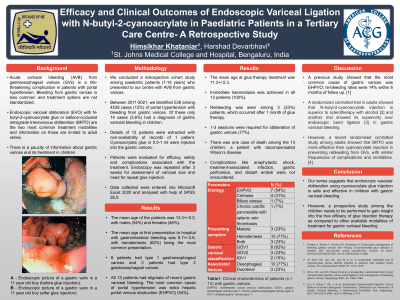Back


Poster Session A - Sunday Afternoon
Category: Pediatrics
A0605 - Efficacy and Clinical Outcomes of Endoscopic Variceal Ligation With N-butyl-2-cyanoacrylate in Pediatric Patients in a Tertiary Care Center - A Retrospective Study
Sunday, October 23, 2022
5:00 PM – 7:00 PM ET
Location: Crown Ballroom

Has Audio

Himsikhar Khataniar
St. Johns Medical College
Bengaluru, Karnataka, India
Presenting Author(s)
Himsikhar Khataniar, 1, Harshad Devarbhavi, MD, DM2
1St. Johns Medical College, Bengaluru, Karnataka, India; 2St. Johns Medical College and Hospital, Bengaluru, Karnataka, India
Introduction: Acute variceal bleeding (AVB) from gastroesophageal varices is a life-threatening complication in patients with portal hypertension. Bleeding from gastric varices is less common and treatment options are not standardized. Endoscopic variceal obliteration (EVO) with N-butyl-2-cyanoacrylate glue or balloon-occluded retrograde transvenous obliteration (BRTO) are the two most common treatment modalities and information on these are limited to adult series. There is paucity of information about gastric varices and its treatment in children.
Methods: We conducted a retrospective cohort study among pediatric patients (1-18 years) who presented to our center with AVB from gastric varices. Between 2011-2021, we identified 538 among 4539 cases (12%) of portal hypertension with bleeding from gastric varices. Of these only 14 cases (2.6%) had a diagnosis of gastric variceal bleeding in children. Details of 13 patients were extracted with non-availability of records of 1 patient. Cyanoacrylate glue in 0.5-1 ml were injected in to the gastric varices. Patients were evaluated for efficacy, safety and complications associated with the treatment. Endoscopy was repeated after 3 weeks for assessment of variceal size and need for repeat glue injection.
Results: The mean age of the patients was 13.3+/-5.2, with males (54%) and females (46%). The mean age at first presentation to hospital with gastrointestinal bleeding was 8.7+/-3.6, with hematemesis (62%) being the most common presentation. On endoscopy, 8 patients had type 1 gastro-esophageal varices and 3 patients had type 2 gastroesophageal varices. All 13 patients had stigmata of recent gastric variceal bleeding. The most common cause of portal hypertension was extra hepatic portal venous obstruction (EHPVO) (54%). The mean age at glue therapy treatment was 11.3+/-5.3. While immediate hemostasis was achieved in all 13 patients (100%) with gastric variceal bleeding, re-bleeding was seen among 3 patients, which occurred after 1 month of glue therapy. 1-3 sessions were required for obliteration of gastric varices. There was one case of death among the 13 children: a patient with decompensated Wilson’s disease. We did not encounter complications like anaphylactic shock, treatment-associated infection, gastric perforation, and distant emboli.
Discussion: The experience from our series suggests that endoscopic vascular obliteration using cyanoacrylate glue injection is safe and effective in children with gastric variceal bleeding.
Disclosures:
Himsikhar Khataniar, 1, Harshad Devarbhavi, MD, DM2. A0605 - Efficacy and Clinical Outcomes of Endoscopic Variceal Ligation With N-butyl-2-cyanoacrylate in Pediatric Patients in a Tertiary Care Center - A Retrospective Study, ACG 2022 Annual Scientific Meeting Abstracts. Charlotte, NC: American College of Gastroenterology.
1St. Johns Medical College, Bengaluru, Karnataka, India; 2St. Johns Medical College and Hospital, Bengaluru, Karnataka, India
Introduction: Acute variceal bleeding (AVB) from gastroesophageal varices is a life-threatening complication in patients with portal hypertension. Bleeding from gastric varices is less common and treatment options are not standardized. Endoscopic variceal obliteration (EVO) with N-butyl-2-cyanoacrylate glue or balloon-occluded retrograde transvenous obliteration (BRTO) are the two most common treatment modalities and information on these are limited to adult series. There is paucity of information about gastric varices and its treatment in children.
Methods: We conducted a retrospective cohort study among pediatric patients (1-18 years) who presented to our center with AVB from gastric varices. Between 2011-2021, we identified 538 among 4539 cases (12%) of portal hypertension with bleeding from gastric varices. Of these only 14 cases (2.6%) had a diagnosis of gastric variceal bleeding in children. Details of 13 patients were extracted with non-availability of records of 1 patient. Cyanoacrylate glue in 0.5-1 ml were injected in to the gastric varices. Patients were evaluated for efficacy, safety and complications associated with the treatment. Endoscopy was repeated after 3 weeks for assessment of variceal size and need for repeat glue injection.
Results: The mean age of the patients was 13.3+/-5.2, with males (54%) and females (46%). The mean age at first presentation to hospital with gastrointestinal bleeding was 8.7+/-3.6, with hematemesis (62%) being the most common presentation. On endoscopy, 8 patients had type 1 gastro-esophageal varices and 3 patients had type 2 gastroesophageal varices. All 13 patients had stigmata of recent gastric variceal bleeding. The most common cause of portal hypertension was extra hepatic portal venous obstruction (EHPVO) (54%). The mean age at glue therapy treatment was 11.3+/-5.3. While immediate hemostasis was achieved in all 13 patients (100%) with gastric variceal bleeding, re-bleeding was seen among 3 patients, which occurred after 1 month of glue therapy. 1-3 sessions were required for obliteration of gastric varices. There was one case of death among the 13 children: a patient with decompensated Wilson’s disease. We did not encounter complications like anaphylactic shock, treatment-associated infection, gastric perforation, and distant emboli.
Discussion: The experience from our series suggests that endoscopic vascular obliteration using cyanoacrylate glue injection is safe and effective in children with gastric variceal bleeding.
Disclosures:
Himsikhar Khataniar indicated no relevant financial relationships.
Harshad Devarbhavi indicated no relevant financial relationships.
Himsikhar Khataniar, 1, Harshad Devarbhavi, MD, DM2. A0605 - Efficacy and Clinical Outcomes of Endoscopic Variceal Ligation With N-butyl-2-cyanoacrylate in Pediatric Patients in a Tertiary Care Center - A Retrospective Study, ACG 2022 Annual Scientific Meeting Abstracts. Charlotte, NC: American College of Gastroenterology.
